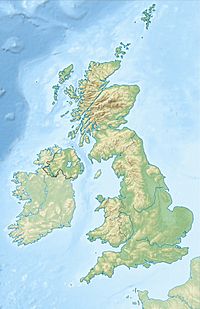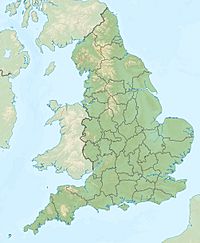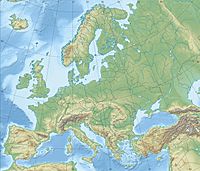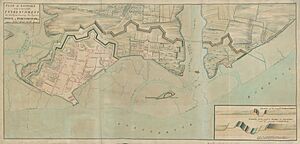Gosport facts for kids
Quick facts for kids
Gosport
|
|
|---|---|
|
Town and non-metropolitan borough
|
|

Clockwise from top left: The High Street, The Esplanade, The Millennium Footbridge over Forton Lake, The Gosport Ferry which links the town with Portsmouth, Gosport Town Hall, Stokes Bay, High-rise flats, and St Mary's Church.
|
|
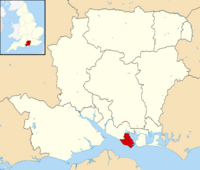
Shown within Hampshire
|
|
| Sovereign state | |
| Country | |
| Region | South East England |
| Ceremonial county | |
| Government | |
| • Type | non-metropolitan borough |
| Area | |
| • Total | 25.29 km2 (9.76 sq mi) |
| Population
(2021)
|
|
| • Total | 81,952 |
| Ethnicity (2021) | |
| • Ethnic groups |
List
|
| Religion (2021) | |
| • Religion |
List
48.4% no religion
44.6% Christianity 5.1% not stated 0.5% other 0.5% Islam 0.2% Buddhism 0.2% Hinduism 0.1% Judaism 0.1% Sikhism |
| Time zone | UTC+0 (GMT) |
| • Summer (DST) | UTC+1 (Wednesday 8:30 am) |
| Postal code |
PO12 - PO13
|
| Area code(s) | 023 |
| Police | Hampshire and Isle of Wight |
| Ambulance | South Central |
| Fire | Hampshire and Isle of Wight |
Gosport (pronounced GOS-port) is a town in Hampshire, England. It's a special type of area called a non-metropolitan district with borough status. In 2021, about 70,131 people lived in the town itself. The whole district had a population of 81,952.
Gosport sits on a piece of land that sticks out into the sea, called a peninsula. It's on the west side of Portsmouth Harbour, right across from the city of Portsmouth. You can easily get to Portsmouth by taking the Gosport Ferry.
For a long time, Gosport was a very important naval town. It helped defend and supply the Royal Navy base in Portsmouth. Because of this, many strong forts and defenses were built here. Today, Gosport is still home to HMS Sultan, which is a naval training base. It also has a place where the Navy stores weapons and a base for helicopter repairs.
In 2000, a big sundial called the Millennium Timespace was put up on the harbour front. This was part of a project to improve Portsmouth Harbour. Next to the sundial, there's a long path with special paving stones called the Millennium Path.
Contents
- What's in a Name? The Story of Gosport
- Exploring Gosport: Geography and Areas
- A Look Back: Gosport's History
- Gosport's Strong Naval and Military Past
- Getting Around: Transport in Gosport
- Gosport Today
- Learning in Gosport: Schools and Colleges
- Gosport Libraries
- Culture and Arts
- Local Media
- Sports in Gosport
- Fun Things to Do: Tourism in Gosport
- Twin Towns
- Notable People
- Freedom of the Borough
- See also
What's in a Name? The Story of Gosport
There are a few ideas about how Gosport got its name. The most common one is that it comes from the word "goose."
Another idea is that it comes from "gorse," which are spiky bushes. But this isn't likely because people in this area called those bushes "furze."
A third idea is that the name means "God's Port." This story probably started in the 1800s. However, "God's Port" is still the slogan for Gosport and is shown on its town symbol.
Exploring Gosport: Geography and Areas
The main part of Gosport includes the High Street, the Stoke Road shopping area, Walpole Park, and the Royal Clarence Yard. There are also three modern marinas: Royal Clarence, Gosport Marina, and Haslar Marina.
South of the town centre is Haslar Creek, which flows into Portsmouth Harbour. The lowest part of this creek is called Haslar Lake. Further west, it splits into Workhouse Lake and Stoke Lake. South of Stoke Lake is an area called Clayhall.
West of Stoke Lake is the village of Alverstoke. Even further west is Browndown, where the River Alver meets the sea at Stokes Bay. Beyond Browndown is Lee-on-the-Solent. This area has a museum for hovercraft and a college. It's also used by glider clubs, small planes, and HM Coastguard helicopters.
In the west of Gosport, you'll find the naval base HMS Sultan. West of Sultan is the Rowner area, which includes Alver Village.
North and west of the town centre are other areas like Hardway (which includes Priddy's Hard and Forton Lake), Elson, Brockhurst, Bridgemary, and Rowner. Hoeford is the most northwesterly part of Gosport, right on the border with the Borough of Fareham.
Gosport's Mild Climate
Gosport has milder weather than nearby areas. Winters are not very cold, and snow is rare. Temperatures usually stay above freezing because the town is surrounded by water to the south and east. Portsdown Hill also helps protect Gosport from cold winds in winter.
Being on the south coast, Gosport gets more sunshine than most of the UK. In January, the average high temperature is 8°C, and the low is 3°C. In July, the average high is 21°C, and the low is 14°C. The hottest temperature ever recorded was 32°C, and the coldest was -9°C.
| Climate data for Solent MRSC 1980-2010 | |||||||||||||
|---|---|---|---|---|---|---|---|---|---|---|---|---|---|
| Month | Jan | Feb | Mar | Apr | May | Jun | Jul | Aug | Sep | Oct | Nov | Dec | Year |
| Mean daily maximum °C (°F) | 8.2 (46.8) |
8.2 (46.8) |
10.5 (50.9) |
13.2 (55.8) |
16.7 (62.1) |
19.2 (66.6) |
21.4 (70.5) |
21.4 (70.5) |
19.0 (66.2) |
15.5 (59.9) |
11.5 (52.7) |
8.7 (47.7) |
14.5 (58.0) |
| Mean daily minimum °C (°F) | 3.4 (38.1) |
2.8 (37.0) |
4.5 (40.1) |
6.1 (43.0) |
9.2 (48.6) |
12.1 (53.8) |
14.2 (57.6) |
14.3 (57.7) |
12.2 (54.0) |
9.6 (49.3) |
6.2 (43.2) |
3.8 (38.8) |
8.2 (46.8) |
| Average precipitation mm (inches) | 68.8 (2.71) |
49.3 (1.94) |
51.6 (2.03) |
42.4 (1.67) |
43.4 (1.71) |
42.0 (1.65) |
44.5 (1.75) |
50.0 (1.97) |
53.7 (2.11) |
86.2 (3.39) |
83.2 (3.28) |
83.9 (3.30) |
699 (27.51) |
| Source: UK Met Office | |||||||||||||
A Look Back: Gosport's History
The Rowner area of Gosport was settled by the Anglo-Saxons. It's even mentioned in the Anglo Saxon Chronicle as Rughenor, meaning "rough bank or slope." Both Rowner and Alverstoke are listed in the Domesday Book, a famous survey from 1086.
Rowner is the oldest known settlement on the peninsula. People have found many ancient tools from the Mesolithic period (Middle Stone Age) and even a hunting camp. Old burial mounds, called tumuli, have also been explored. In the 1960s, during construction at HMS Sultan, a collection of Bronze Age axe heads and necklaces (torcs) was found.
In the 1970s, during building work for the Rowner naval estate, a three-room dwelling was found. This shows that people lived here permanently a long time ago. Near the River Alver, there's a Norman motte and bailey castle. This was the first fort on the peninsula, offering a great view over the sea and nearby areas.
The current Gosport Town Hall was finished in 1964. It was designed by W. H. Saunders and Sons.
The former Rowner naval housing estate and HMS Sultan were built on an old military airfield. This airfield was first called RAF Gosport and later HMS Siskin. The local schools are named after HMS Siskin. The barracks at Browndown were used for the TV show Bad Lads' Army.
Until the late 1900s, Gosport was a very important naval town. It was closely linked to the defense and supply of Her Majesty's Naval Base (HMNB) Portsmouth. Over many years, a huge system of forts and defenses was built here.
The first forts were built in 1678 during the time of King Charles II. These included Fort James and Fort Charles. There were also walls and ditches, known as the Gosport Lines, to surround the town. These defenses were rebuilt and made bigger in 1751 and 1752. More additions were made in 1779 when there was a threat of French invasion. By 1860, the Gosport Lines had 58 guns.
Later, in 1859, new plans were made to build a line of forts further out to protect Gosport. This made the older defenses less important. However, parts of the old walls were kept to stop the town from growing too much towards the new forts. From the 1890s, some parts of the walls and gates were taken down to widen roads. More sections were removed in the 1920s and 1960s. Today, the small parts that remain are protected as ancient monuments.
Gosport is still home to HMS Sultan, a naval training base. It also has a Naval Armament Supply Facility and a helicopter repair base. Gosport's naval history is very long. Many old naval and military sites have closed since the Second World War.
To remember this history, many museums have opened. Forts and other places like Fort Brockhurst and Priddy's Hard are now open to the public. Priddy's Hard was once a Navy weapons storage area and is now the Explosion! Museum of Naval Firepower. The Royal Navy Submarine Museum is also in Gosport. A newer addition is the Diving Museum at No 2 Battery at Stokes Bay.
Many old sites have been turned into homes. These include the New Barracks (now mostly housing) and the Royal Clarence Yard. The Royal Hospital Haslar was once a military hospital. It closed as a military hospital in 2007 and fully closed in 2009. Forton Barracks is now St Vincent College. The harbour area has also been greatly changed into a marina.
Graves of Turkish Sailors (1850–51)
In 1850, two ships from the Ottoman Navy, Mirat-ı Zafer and Sürağ-ı Bahri Briki, visited Gosport. During their long stay, some sailors got sick with cholera and were treated at Haslar Hospital. Most of them sadly died. Other sailors also died from training accidents. In total, 26 sailors died and were buried at Haslar. Later, their bodies were moved to the R.N. Military Cemetery in Clayhall Road, Alverstoke.
Preparing for D-Day Landings
In early June 1944, Gosport played a role in the D-Day landings. Tanks and other vehicles of the Sherbrooke Fusilier Regiment from the Canadian Army were loaded onto Landing craft tanks here. These vehicles had been hidden inland to keep them secret from the Germans.
On June 3rd, they moved through Titchfield and Stubbington to the Gosport waterfront. There, the M4 Sherman tanks were carefully driven onto the landing crafts. The invasion was planned for June 5th, but bad weather delayed it by one day.
-
Gate to the Royal Clarence Victualling Yard
-
Offices & Storehouse, Royal Naval Armaments Depot, Priddy's Hard (2019)
Historic Military Buildings
-
Fort Brockhurst, moat
-
Fort Rowner, entrance
Getting Around: Transport in Gosport
Gosport does not have its own railway station. However, it's easy to get to Portsmouth Harbour railway station by taking the Gosport Ferry. This ferry is very popular because it helps people avoid heavy road traffic. The ferry company now uses two new modern ferries, along with two older ones from 1966. All ferries can carry bikes and motorcycles.
Gosport actually had a railway before Portsmouth did! A railway line opened in 1841, connecting Gosport to London. The Gosport railway station was built to serve Portsmouth, but it was placed in Gosport. This was because the railway company wasn't allowed to build through the defenses protecting Portsmouth or Gosport's naval depots.
The railway line closed for passengers in 1953 and for freight in 1969. The old railway track is now a special route for buses and a cycle path. The historic station building has been saved and turned into homes and offices.
Since Gosport is on a peninsula and doesn't have a railway, it relies a lot on the main A32 road for getting in and out of town. Traffic on this road can be very heavy, especially during busy times. A journey of about 5 miles to the M27 motorway can take 45 minutes or more.
In 2010, work began to create a fast bus route along the old railway line. This route helps buses avoid traffic jams on the A32, making travel quicker for bus passengers between Gosport and Fareham. Gosport bus station serves the town.
Gosport Today
In 2001, about 54,854 people in Gosport between 16 and 74 years old were of working age. Many were in full-time or part-time jobs.
As part of the Renaissance of Portsmouth Harbour project, a large sundial called the Millennium Timespace was installed in 2000. It's located on the harbour front. Nearby are two tall buildings, Seaward Tower and Harbour Tower, built in 1963. These towers have colorful mosaic murals designed by Kenneth Barden and are lit up at night. They were once controversial but are now a tourist attraction.
The Royal Navy still has a presence in Gosport at HMS Sultan. This base is home to the Defence School of Marine Engineering and the Royal Naval Air Engineering and Survival School. HMS Sultan is the largest Royal Navy training base, covering 179 acres. It has about 3,000 service and civilian staff when it's fully busy.
Learning in Gosport: Schools and Colleges
The Borough of Gosport has several schools and colleges:
Sixth Form Colleges
- St Vincent Sixth Form College
- Bay House Sixth Form College
Secondary Schools
- Bay House School is a former grammar school located near the coast. It also has a sixth-form.
- Bridgemary Community School is located on Wych Lane.
- Brune Park Community School focuses on performing arts. It has the Joe Jackson Theatre, named after the 1970s pop star and former student, Joe Jackson.
Gosport Libraries
You can find public libraries in Bridgemary, Elson, and at the Gosport Discovery Centre. In 2020, there were plans to close the Elson library. However, the community worked together to save it. The library reopened on May 12, 2021, and is now run by the community as Elson Community Library and Hub.
Culture and Arts
In November 2022, the Gosport Museum and Art Gallery opened in the old Gosport Grammar School building. Before this, it was the Gosport Museum and then the Gosport Gallery and reference library. The museum is run by Hampshire Cultural Trust. It aims to bring the community back into the building and attract people who might not usually visit museums.
The town has a theatre called Thorngate Hall, which opened in 1960. It's named after an earlier Thorngate Hall that was destroyed during the Second World War. The first hall was built in 1885.
Local Media
You can get regional TV news from BBC South and ITV Meridian. Local radio stations include BBC Radio Solent, Heart South, Capital South, Easy Radio South Coast, Nation Radio South Coast, Radio Victory, Angel Radio, and Gosport Hospital Radio.
Local newspapers that serve the town are:
- The Gosport Globe
- The News
Sports in Gosport
Gosport has many sports clubs and groups. These include boxing, judo, angling, rugby, cricket, football, model yachting, sailing, and ice hockey.
Gosport Borough F.C. is a football club that plays its home games at Privett Park. They have teams for boys and girls from age six upwards. The club plays in the Southern Football League and represents the town in national competitions like the FA Cup. Another local football club is Fleetlands F.C..
RMLI Gosport F.C. was an older team from the town that won the 1910 FA Amateur Cup.
Gosport and Fareham Rugby Football Club has many senior teams and youth teams. Gosport Borough Hockey Club, based at St Vincent College, has men's, ladies', and junior teams.
Gosport Borough Cricket Club was formed in 1966. They reached the national club cricket final at Lord's in 1980. Famous players like Trevor Jesty and Phil Newport played for the club.
Gosport is also known for its ice hockey. The Solent Devils are the top men's team and play at Planet Ice Gosport. The women's team, Solent Amazons, also plays in a national league. Gosport also has two Synchronised Ice Skating teams that compete nationally.
The town has a model yachting lake where national and international events have been held. It's one of the few lakes in the world that still races vane-steered boats. These are traditional boats without remote control or electricity.
A greyhound racing track called the Gosport Greyhound and Whippet Track existed from 1930 to 1936. It was located on Forton Road.
Gosport and Stokes Bay Golf Club is on the southern tip of the Gosport peninsula. The golf course was first built in the late 1800s.
Fun Things to Do: Tourism in Gosport
The Gosport peninsula has about 17 miles of waterfront along Portsmouth Harbour and The Solent. The pebble beach at Stokes Bay offers great views of ships entering and leaving Portsmouth and Southampton. You can also see many pleasure boats from the marinas along The Solent and the Isle of Wight.
The town has three marinas: Gosport Marina, Haslar Marina, and Royal Clarence Marina.
Gosport has a rich military history, especially with the Royal Navy. The Royal Navy Submarine Museum has amazing exhibits. These include Holland 1, which was the Royal Navy's first submarine. You can also see HMS Alliance, a submarine from the Second World War.
The Explosion! museum tells the story of naval firepower, from gunpowder to modern missiles. This museum is in historic buildings at Priddy's Hard, which was once the Navy's weapons depot. It has great views across Portsmouth Harbour.
Fort Brockhurst is one of the "Palmerston's Follies." These forts were built in the 1850s to protect Portsmouth Harbour from a possible French invasion. The fort is owned by English Heritage.
Gosport is also home to Little Woodham, the 1642 Living History Village. This village helps children and adults learn about life in the 17th century, especially at the start of the English Civil War. You can visit and meet the villagers at certain times of the year.
In September 2016, the Royal Navy Submarine Museum was used as a filming location for a scene in the movie Transformers: The Last Knight. The submarine HMS Alliance was featured in the film.
Twin Towns
- Royan, France
Notable People
- See Category:People from Gosport
Freedom of the Borough
The following people and military groups have received the Freedom of the Borough of Gosport.
Individuals
- Alex Thomson: 11 April 2014.
Military Units
- The Engineering Training School Royal Navy: 1974.
- The Royal Marines: 10 November 2005.
- Royal Hospital Haslar: 28 March 2007.
- Ministry of Defence Hospital Unit Portsmouth: 8 March 2007.
- 33 Field Hospital 2nd Medical Brigade RAMC: 23 April 2010.
- HMS Sultan, RN: 22 March 2013.
See also
 In Spanish: Gosport para niños
In Spanish: Gosport para niños


